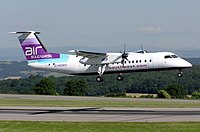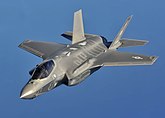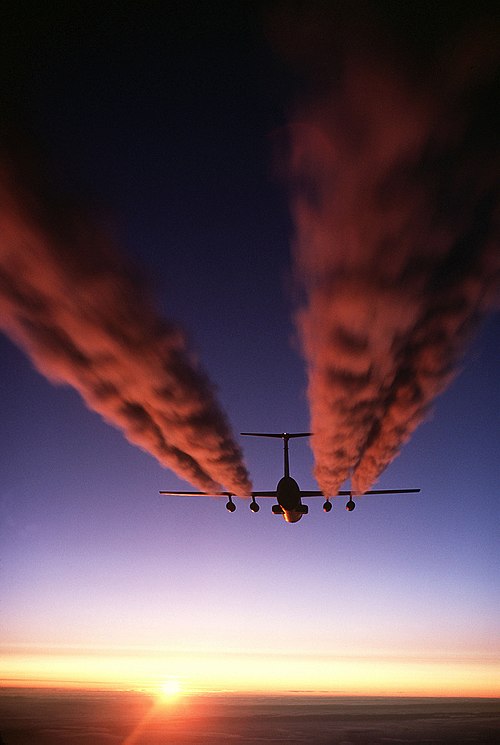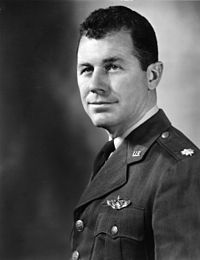Portal:Aviation
| Main page | Categories & Main topics |
|
Tasks and Projects |
The Aviation Portal

Aviation includes the activities surrounding mechanical flight and the aircraft industry. Aircraft includes fixed-wing and rotary-wing types, morphable wings, wing-less lifting bodies, as well as lighter-than-air craft such as hot air balloons and airships.
Aviation began in the 18th century with the development of the hot air balloon, an apparatus capable of atmospheric displacement through buoyancy. Some of the most significant advancements in aviation technology came with the controlled gliding flying of Otto Lilienthal in 1896; then a large step in significance came with the construction of the first powered airplane by the Wright brothers in the early 1900s. Since that time, aviation has been technologically revolutionized by the introduction of the jet which permitted a major form of transport throughout the world. (Full article...)
Selected article
Selected image
Did you know
...that the Fairey Seafox was a Second World War reconnaissance floatplane of the Fleet Air Arm?

...that the Battle of Britain Memorial Flight contains the world's oldest airworthy survivor of the Battle of Britain, alongside ten other historic aircraft - two of which fought over Normandy on D-Day? ... that in the middle of building Fagernes Airport, Leirin, the authorities changed their minds and gave the airport more than twice the runway length?
General images -
In the news
- May 29: Austrian Airlines cancels Moscow-bound flight after Russia refuses a reroute outside Belarusian airspace
- August 8: Passenger flight crashes upon landing at Calicut airport in India
- June 4: Power firm helicopter strikes cables, crashes near Fairfield, California
- January 29: Former basketball player Kobe Bryant dies in helicopter crash, aged 41
- January 13: Iran admits downing Ukrainian jet, cites 'human error'
- January 10: Fire erupts in parking structure at Sola Airport, Norway
- October 27: US announces restrictions on flying to Cuba
- October 3: World War II era plane crashes in Connecticut, US, killing at least seven
- September 10: Nevada prop plane crash near Las Vegas leaves two dead, three injured
- August 6: French inventor Franky Zapata successfully crosses English Channel on jet-powered hoverboard
Related portals
Associated Wikimedia
The following Wikimedia Foundation sister projects provide more on this subject:
-
Commons
Free media repository -
Wikibooks
Free textbooks and manuals -
Wikidata
Free knowledge base -
Wikinews
Free-content news -
Wikiquote
Collection of quotations -
Wikisource
Free-content library -
Wikiversity
Free learning tools -
Wikivoyage
Free travel guide -
Wiktionary
Dictionary and thesaurus
Selected biography
His career began in World War II as a private in the U.S. Army Air Forces. After serving as an aircraft mechanic, in September 1942 he entered enlisted pilot training and upon graduation was promoted to the rank of Flight Officer (WW 2 U.S. Army Air Forces rank equivalent to Warrant Officer) and became a P-51 Mustang fighter pilot. After the war he became a test pilot of many kinds of aircraft and rocket planes. Yeager was the first man to break the sound barrier on October 14, 1947, flying the experimental Bell X-1 at Mach 1 at an altitude of 45,000 ft (13,700 m). Although Scott Crossfield was the first man to fly faster than Mach 2 in 1953, Yeager shortly thereafter exceeded Mach 2.4.[1] He later commanded fighter squadrons and wings in Germany and in Southeast Asia during the Vietnam War, and in recognition of the outstanding performance ratings of those units he then was promoted to Brigadier-General. Yeager's flying career spans more than sixty years and has taken him to every corner of the globe, even into the Soviet Union during the height of the Cold War.
Selected Aircraft

The de Havilland Canada DHC-8, popularly the Dash 8, is a series of twin-turboprop airliners designed by de Havilland Canada in the early 1980s. They are now made by Bombardier Aerospace which purchased DHC from Boeing in 1992. Since 1996 the aircraft have been known as the Q Series, for "quiet", due to installation of the Active Noise and Vibration Suppression (ANVS) system designed to reduce cabin noise and vibration levels to near those of jet airliners.
Notable features of the Dash 8 design are the large T-tail intended to keep the tail free of propwash during takeoff, a very high aspect ratio wing, the elongated engine nacelles also holding the rearward-folding landing gear, and the pointed nose profile. First flight was in 1983, and the plane entered service in 1984 with NorOntair. Piedmont Airlines (formerly Henson Airlines) was the US launch customer for the Dash 8 in 1984.
The Dash 8 design had better cruise performance than the earlier Dash 7, was less expensive to operate, and more notably, much less expensive to maintain. The Dash 8 had the lowest costs per passenger mile of any feederliner of the era. The only disadvantage compared to the earlier Dash 7 was somewhat higher noise levels, but only in comparison as the Dash 7 was notable in the industry for extremely low noise due to its four very large and slow-turning propellers.
- Length: 107 ft 9 in (32.84 m)
- Wingspan: 93 ft 3 in (32.84 m)
- Height: 27 ft 5 in (8.34 m)
- Powerplant: 2× Pratt & Whitney Canada PW150A turboprops, 5,071 shp (3,781 kW) each
- Cruise speed: 360 knots (414 mph, 667 km/h)
- Maiden Flight: June 20, 1983
Today in Aviation
- 2011 – The Libyan government claims that NATO air raids have killed 718 civilians and injured more than 4,000 since the international bombing campaign to enforce a no-fly zone over Libya began.[2]
- 2008 – Champion Air ceased operations because of high fuel prices and fuel inefficiency, the main two reasons the airline was terminated.
- 2008 – Launch: Space Shuttle Discovery STS-124 at 21:02:12 UTC. Mission highlights: ISS assembly flight 1J: JEM - Japanese module Kibo & JEM RMS.
- 2002 – First flight of the Toyota TAA-1
- 1995 – The first flight of the Schweizer RU-38 Twin Condor long-range surveillance aircraft takes place in Elmira, New York.
- 1991 – First flight of the Pilatus PC-12
- 1978 – First flight of the RFB Fantrainer
- 1977 – The Vietnam People's Air Force is separated from the Vietnamese Air Defense Force.
- 1973 – Indian Airlines Flight 440, a Boeing 737, crashes while on approach to Palam Airport in New Delhi, India. 48 of the 65 passengers and crew on board are killed in the accident.
- 1968 – Lockheed U-2, 56-6954, Article 394, fourth airframe of the USAF supplementary production, delivered to the USAF in March 1959. Built as a two-place airframe for ARDC at Edwards AFB, California - later designated a U-2D. Transferred to SAC in 1966 and converted to U-2C by January 1967. Crashed this date near Tucson, Arizona. Pilot Maj. Vic Milam ejects safely at 41,000 feet after losing control when airframe experiences uncontrolled pitch-up.
- 1968 – Lockheed JQF-104A Starfighter drone, 56-0733, 'QFG-733', (so modified and designated on November 29, 1961), of the 3205th Drone Squadron, suffers a severe class A landing accident at Eglin AFB, Florida. Repaired.
- 1967 – A USAF KC-135 Stratotanker makes an emergency refuelling of six US Navy jets.
- 1957 – A Royal Canadian Navy McDonnell F2H-3 Banshee fighter jet, BuNo 126313, Sqn. No. 104 of VF-870, spirals out of control after its right wing breaks in half during a high-speed flyby at naval air station HMCS Shearwater, Nova Scotia, Canada. The canopy is observed to separate from the aircraft, but the pilot, Lt. Derek Prout, fails to eject and is killed when the plane slams into McNabs Island. The crash is attributed to improperly manufactured fittings in the folding wing mechanism, and most RCN and US Navy Banshees are grounded until improved fittings can be installed.
- 1946 – London Heathrow Airport is officially opened.
- 1942 – Nos. 405, 408, 419 and 420 (Bomber) Squadrons participated in the first 1,000 aircraft attack on Germany, directed at Cologne.
- 1942 – Since January 1, Royal Air Force Bomber Command has dispatched 12,029 sorties, losing 396 aircraft; German night fighters have shot down 167 of them, an average of 34 British bombers per month. Since February 1, aircraft losses in British bombing raids on Germany have averaged 3.7 percent.
- 1941 – The Anglo-Iraq War ends with the collapse of Iraqi resistance.
- 1939 – Italian forces, including the “legionary air force, ” depart Spain.
- 1935 – First flight of the Fairchild Model 45
- 1935 – Hickam Field is dedicated in the Territory of Hawaii.
- 1928 – (May 31 and June 9) The first airplane flight across the Pacific is made by British Capt. Charles Kingsford-Smith and crew in a Fokker F-VIIB/3 m Southern Cross. They fly from Oakland Field, California to Brisbane, Australia, 7,389 miles (11,890 km), in 83 hours, 38 min. On the way, it becomes the first airplane to land in Fiji.
- 1919 – NC-4 aircraft commanded by AC Read completes first crossing of the Atlantic.
- 1919 – First wedding held in an aircraft. Flying 2000 ft above Houston Texas in a converted Hadley Page bomber, Marjorie Dumont and Lt. R. W. Meade were married by an Army chaplain.
- 1918 – Douglas Campbell scores his fifth victory, becoming the first American pilot to become an ace while flying for an American unit.
- 1916 – A Short Type 184 from the Royal Navy seaplane carrier Engadine achieves the only British aerial reconnaissance flight of the Battle of Jutland, reporting the sighting of three cruisers and ten destroyers of the German High Seas Fleet before a broken fuel pipe forces it to end the mission.
- 1911 – Andre Beaumont beats Roland Garros in the Paris to Rome air race, completing the 1,465 km (910 mile) course in 28 hours, 5 min.
- 1910 – Glenn Curtiss wins a $10,000 (USD) prize from the New York World for flying in his Hudson Flyer from Albany, New York, to New York City in 2 hours 51 min, following the course of the Hudson River.
- 1862 – Information obtained from Thadeus S. C. Lowe's balloon observation saves Union forces from defeat at the Battle of Fair Oaks, Virginia during the U. S. Civil War. Union General George McClellan is warned by Lowe of Confederate General Albert Johnston's approaching troops.
- 1811 – Albrecht Ludwig Berblinger, the "tailor of Ulm" (Germany) crashes in his apparatus, a copy of Degen's, into the Danube. It was presumably a workable hang glider.
References
- ^ Yeager, Chuck and Janos, Leo. Yeager: An Autobiography. p. 252 (paperback). New York: Bantam Books, 1986. ISBN 0-553-25674-2.
- ^ Staff (31 May 2011). "Libya Says Nato Air Raids 'Killed 700 Civilians'". BBC News (31 May 2011). Retrieved 18 August 2011.
- ^ "Italy copter crash in Iraq kills 4". CNN.com. 2005-05-31. Archived from the original on March 9, 2007. Retrieved 2007-12-19.
- Shortcuts to this page: Portal:Airplanes • P:AVIA





















































